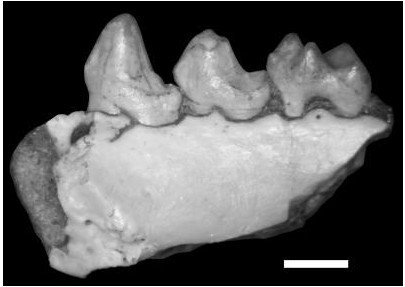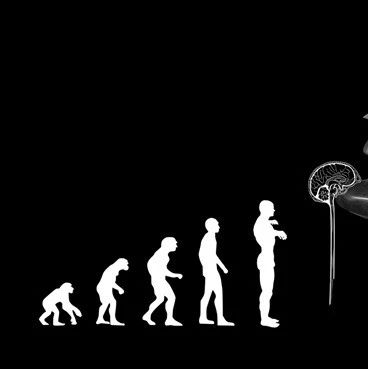摘要:近日,人类学家Chris Kirk宣布在西德克萨斯“魔鬼的墓地”发现了一种鲜为人知的灵长类动物化石,称为Mescalerolemur horneri,他们生活在距今4300万年前的第三纪下层时期,跟现在的一种狐猴很相似,是灵长类灭绝群体adapiforms的成员之一,其踪迹遍布整个第三纪下层时期的北半球,然而,就像Mahgarita stevensi(1973年在同样的地方发现的一种更早期的灵长类化石)一样,Mescalerolemur更接近于欧亚和非洲的早期人类。

This is Mescalerolemur horneri's partial upper jaw (in two pieces, at left) and partial lower jaw (at right) (scales = 2 mm).

This is Mescalerolemur horneri's partial right lower jaw (scale = 2 mm).
"These Texas primates are unlike any other Eocene primate community that has ever been found in terms of the species that are represented," says Kirk, associate professor in the Department of Anthropology at The University of Texas at Austin. "The presence of both Mescalerolemur and Mahgarita, which are only found in the Big Bend region of Texas, comes after the more common adapiforms from the Eocene of North America had already become extinct. This is significant because it provides further evidence of faunal interchange between North America and East Asia during the Middle Eocene."
By the end of the Eocene, primates and other tropically adapted species had all but disappeared from North America due to climatic cooling, so Kirk is sampling the last burst of diversity in North American primates. With its lower latitudes and more equable climate, West Texas offered warm-adapted species a greater chance of survival after the cooling began.
Kirk says Marie Butcher, a then undergraduate who graduated with degrees in anthropology and biology from The University of Texas at Austin, found the first isolated tooth of Mescalerolemur in 2005. Since that time, many more primate fossils have been recovered by Kirk and more than 20 student volunteers at a locality called "Purple Bench." This fossil locality is three to four million years older than the Devil's Graveyard sediments that had previously produced Mahgarita stevensi.
"I initially thought that we had found a new, smaller species of Mahgarita," Kirk says.
However, as more specimens were prepared at the Texas Memorial Museum's Vertebrate Paleontology Lab, Kirk realized he had discovered not just a new species, but a new genus that was previously unknown to science.
Fossils of Mescalerolemur reveal it was a small primate, weighing only about 370 grams. This body weight is similar to that of the living greater dwarf lemur. Mescalerolemur's dental anatomy reveals a close evolutionary relationship with adapiform primates from Eurasia and Africa, including Darwinius masillae, a German fossil primate previously claimed to be a human ancestor. However, the discovery of Mescalerolemur provides further evidence that adapiform primates like Darwinius are more closely related to living lemurs and bush babies than they are to humans.
For example, the right and left halves of Mescalerolemur's lower jaws were two separate bones with a joint along the midline, a common trait for lemurs and bush babies. Mahgarita stevensi, the closest fossil relative of Mescalerolemur, had a completely fused jaw joint like that of humans.
"Because Mescalerolemur and Mahgarita are close relatives, fusion of the lower jaws in Mahgarita must have occurred independently from that observed in humans and their relatives, the monkeys and apes" Kirk says.
The new genus is named Mescalerolemur after the Mescalero Apache, who inhabited the Big Bend region of Texas from about 1700-1880. The species name, horneri, honors Norman Horner, an entomologist and professor emeritus at Midwestern State University (MSU) in Wichita Falls, Texas. Horner helped to establish MSU's Dalquest Desert Research Site, where the new primate fossils were found.
Kirk and his colleague Blythe Williams of Duke University will publish their findings in the Journal of Human Evolution article, "New adapiform primate of Old World affinities from the Devil's Graveyard Formation of Texas."







